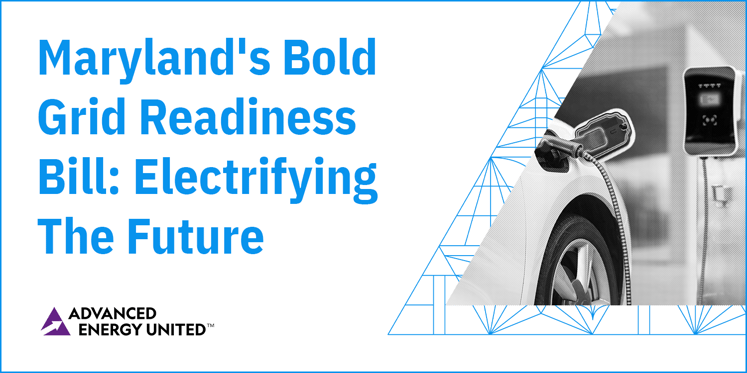
In recent years, Maryland has emerged as a frontrunner in clean energy leadership nationally, fueled by ambitious goals for clean energy and clean transportation. Policies like the Climate Solutions Now Act of 2022, the Advanced Clean Trucks (ACT) Rule, the Advanced Clean Cars II (ACCII) Rule, and the Maryland Building Energy Transition Plan prioritize electric vehicles (EVs), clean energy, and building electrification. However, while these policies are vital and the goals in them need to be met, their full implementation is going to require an electric system that we don’t yet have—and now there is groundbreaking legislation being considered in Annapolis that would address this aspect of the clean energy transition as well.
To better understand the challenge we face, let’s look at some recent data on how much electricity is needed in Maryland to handle the anticipated levels of just transportation electrification. Recent analysis by the Electric Power Research Institute (EPRI) shows that Montgomery County alone will require an additional 1.8 terawatt-hours (TWh) of electricity production to support anticipated levels of light-duty transportation electrification by 2030 – a mere six years away. That’s a nearly 350% increase in electricity usage from just light-duty electric transportation in one county in Maryland. To further illustrate, according to research conducted by National Grid, CALSTART, and RMI, a typical highway rest stop will need about 20 fast chargers for EVs to meet expected demand – that's the equivalent of powering a professional outdoor sports stadium, and about half of the power needed to serve the entire Empire State Building.
It’s not just electric transportation that Maryland has to prepare for; building electrification is skyrocketing too. According to a report released last year from the Building Decarbonization Coalition, Maryland is a national leader in electric heat pump installations, with nearly 25% of all homes in the state equipped with heat pumps as of last June. Two of Maryland’s most populous counties, Montgomery County and Howard County, have both passed legislation to phase out the use of fossil fuels in new construction starting as early as 2027. While fantastic for the state’s climate goals, this acceleration will put new pressures on local distribution systems that are already near capacity. And if the state becomes “winter-peaking” in 2026 or 2027, as predicted by a recent Brattle study, the state will need to plan differently for both how we produce energy and how we consume it.
The auto industry is now fully committed to moving towards a future dominated by EVs, and at the same time, more homes and businesses are increasingly turning away from traditional gas infrastructure in favor of new, high-performance electric system alternatives like heat pump water heaters and air source heat pumps. Traditional long-term “top-down” resource planning will struggle to match the pace at which this transition is taking place, risking delays for Maryland residents and businesses in accessing these superior technologies. Ultimately this issue will require elected officials and decision-makers in Maryland and elsewhere to invest time and attention into this matter, and everyone from EV charging companies to renewable developers to energy efficiency providers have a shared interest in strengthening the grid.
To help ensure Maryland addresses this challenge head-on, United worked with state Senator Katie Fry Hester to develop the recently introduced SB 1083, requiring the state’s Public Service Commission and the utilities it regulates to do their part in getting the grid ready to handle the influx of EVs and building electrification. Recognizing the state’s transportation electrification and decarbonization goals, this bill ensures that the infrastructure needed to meet those goals is put in place on the correct timelines, and ensures that we do so at reasonable cost to electric ratepayers.
To ensure a smooth, reliable, and affordable transition for the state as electrification ramps up, and that everyday Marylanders and Maryland businesses have positive and easy experiences adopting the clean technologies of their choice, Senator Hester’s legislation aims to get Maryland’s grid ready for the daunting, but unquestionably doable, challenge. What does this look like?
- Enhancing the state’s electric distribution system planning system by using more highly localized, “bottom-up” forecasting to identify changes in customer demand down to which homes are likely to adopt EVs, heat pumps, solar or storage technologies;
- Anticipating where the state’s distribution grid will need upgrades to support that electrification;
- Prioritizing electric distribution system upgrades that support overburdened communities, lower electric bills, and/or improve indoor and outdoor air quality;
- Requiring coordination between gas and electric utilities to ensure that the electric system is ready to accommodate new electric appliance load by the time it’s needed by customers and that capital spending on both systems is better optimized for future needs;
- Identifying optimal locations to deploy distributed energy resources such as solar and energy storage systems, based on distribution system and customer needs, location type, decarbonization goals, where overburdened communities might benefit, and more; and
- Creating an electric distribution system “make-ready” fund to help cover the costs of distribution system upgrades with non-ratepayer dollars, including available federal funds.
Ultimately, this is about utilities upgrading their infrastructure in anticipation of increased demand, to improve the customer adoption experience, leverage more distributed energy resources and load flexibility tools and techniques, bolster grid resiliency, support the state’s electrification goals, and mitigate ratepayer impacts.
Senator Hester’s legislation is the best path forward for Maryland to hit its clean energy and clean transportation goals. There is a unique opportunity here to cement Maryland’s status as not only being bold and ambitious in its energy policy but being smart about it too. United is excited to endorse this bill, and we’re dedicated to working with Maryland decision-makers to make this vision a reality.